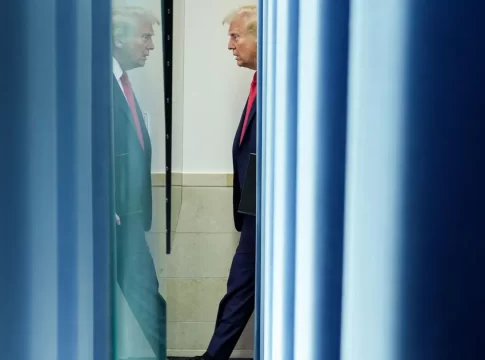As U.S. President Donald Trump announced sweeping tariffs of up to 145% last month, the move sent tremors through global markets. What began as another “America First” policy quickly evolved into a seismic shift, disrupting maritime routes, financial systems, and the fundamental architecture of global trade. Cargo vessels en route to the U.S. turned mid-ocean toward alternative ports. At the Port of Los Angeles, typically the nation’s busiest, cranes froze as one-third of scheduled shipments were canceled almost overnight. But while the visual signs of disruption were stark, a quieter, more impactful change was unfolding deep within the global economy—how companies and nations finance and secure their place in trade.
Behind the scenes, the $9 trillion global trade finance system lurched into action. Major corporations scrambled to access liquidity—tapping credit lines and hoarding cash not out of panic, but calculated caution. According to JP Morgan’s Global Head of Trade Sales Natasha Condon, this was about buying time and leverage. Companies used this liquidity not only to withstand volatility, but to gain bargaining power in negotiations—on tariffs, pricing, and payment terms. Meanwhile, Deutsche Bank’s trade finance head noted that most firms were in a “wait-and-see” mode, hedging risk while sticking to core strategies.
The backdrop is important. Global supply chains have been battered for half a decade—from COVID-19 to the Suez Canal blockage, sanctions, and regional conflicts. Trump’s tariffs are simply the latest blow. But unlike previous shocks, these tariffs are strategic, not reactive. They are designed to corner China and the EU into renegotiating trade terms on America’s terms. By threatening economic pain, Trump is increasing pressure to bring trading partners to the table. This isn’t just policy—it’s hardball negotiation aimed at securing the best possible deal for the U.S..
And yet, this gamble carries risk. The most immediate concern is the growing divide between companies that can survive and those that can’t. Large multinationals with strong credit profiles are using tools like letters of credit, supply chain finance, and self-funded trade deals to keep goods moving. Smaller suppliers, especially in developing economies, face a different reality. With banks tightening standards under new regulations, many can no longer access trade financing. The trade finance gap—already estimated at $2.5 trillion—is expected to grow, cutting off weaker links in global supply chains and adding systemic fragility.
This tightening isn’t just affecting companies. Countries historically dependent on U.S. trade are responding swiftly. Canada, long seen as America’s closest economic partner, has intensified efforts to diversify its export markets. It is accelerating trade ties with the European Union via CETA (the Comprehensive Economic and Trade Agreement), expanding into Asia through CPTPP, and deepening connections with Latin America. European nations, facing Trump’s delayed tariffs on EU goods, are also ramping up intra-EU trade and striking new deals with Middle Eastern, Asian and African partners to reduce reliance on the U.S. Germany, in particular, is boosting export channels to Gulf countries and Southeast Asia, hedging against future instability.
Elsewhere, Japan and regional Asian lenders are capitalizing on the vacuum created by U.S. overreach. As American banks retreat due to political exposure, these institutions are stepping up to finance trade previously routed through the U.S. financial system. A Tokyo banker summarized the sentiment: “Clients are being reminded that U.S. banks are no longer guaranteed to be neutral or reliable in politically sensitive deals.”
The shift is as much about perception as economics. With major Chinese firms like CATL and Tencent blacklisted by the U.S. Defense Department, trust in cross-border U.S.-China financing has eroded. Despite American banks previously underwriting IPOs and investment flows, political actions are redefining who controls access. Sovereign wealth funds in the Middle East and Asia are reevaluating their asset allocations, moving toward gold and safer instruments as hedges against further geopolitical volatility.
Trump may have designed these tariffs to protect American industry and appear tough on trade, but the global ripple effects may ultimately undermine that goal. As cargo ships reroute, financing migrates eastward, and new trade partnerships bloom outside U.S. influence, the risk is clear: the more unpredictable the American market becomes, the more the rest of the world learns how to live without it.
Already, oil prices and gold markets have responded with volatility. Brent crude jumped on concerns over Middle Eastern oil flows and shifting alliances, while gold—traditionally a safe haven—briefly surged before stabilizing when Trump delayed a major EU tariff deadline. These sharp movements underscore a larger truth: Trump’s trade headlines are now a primary driver of global market sentiment.
For Trump, the ultimate prize is leverage—forcing trade partners to the table on his terms. But this brinkmanship is a high-stakes gamble. The longer uncertainty prevails, the more likely global trade realigns away from the U.S. If companies and countries conclude that America is no longer a stable cornerstone of trade, new supply routes and financing structures will change elsewhere. The U.S. may win a battle, but lose the long-term position of dominance and partners’ reliance.
The coming months will determine which direction this fragile balance tips. For now, Trump holds the world in suspense. His next moves—whether compromise or escalation—will determine whether this is remembered as a strategic masterstroke or a miscalculated overreach. But what’s already clear is this: the world is no longer waiting to see what America does. It’s already building Plan B.


